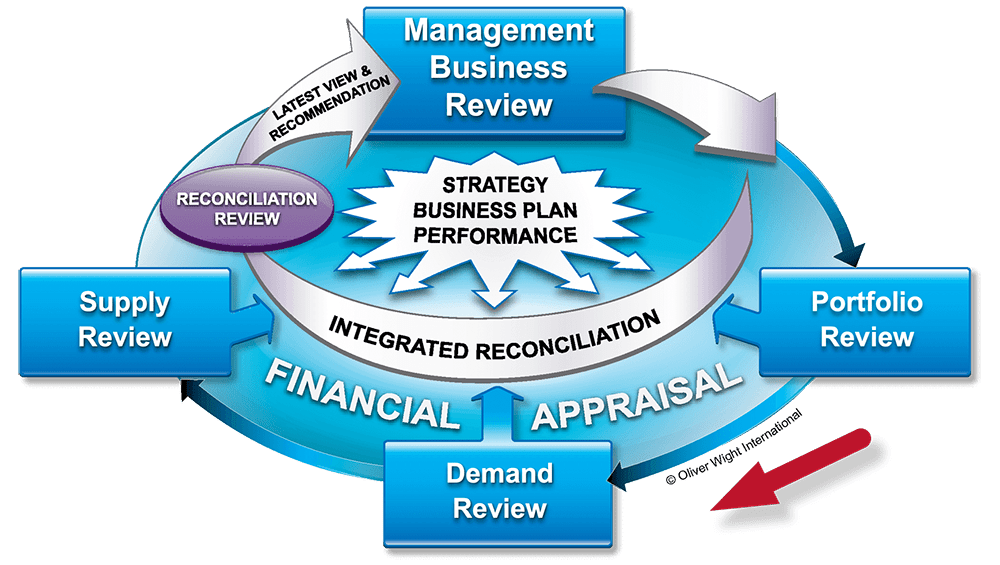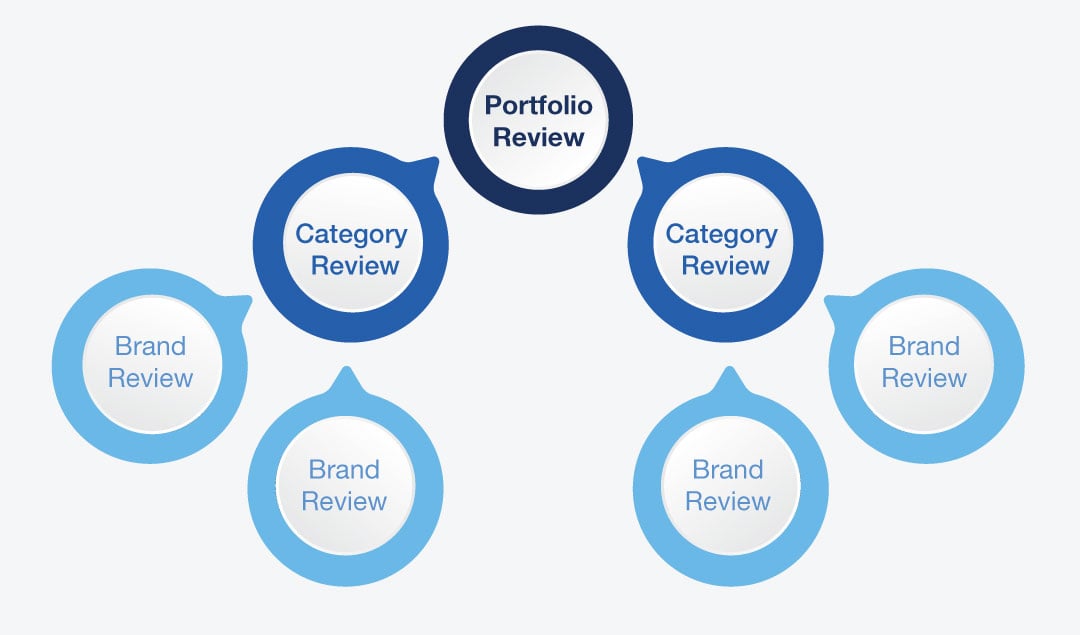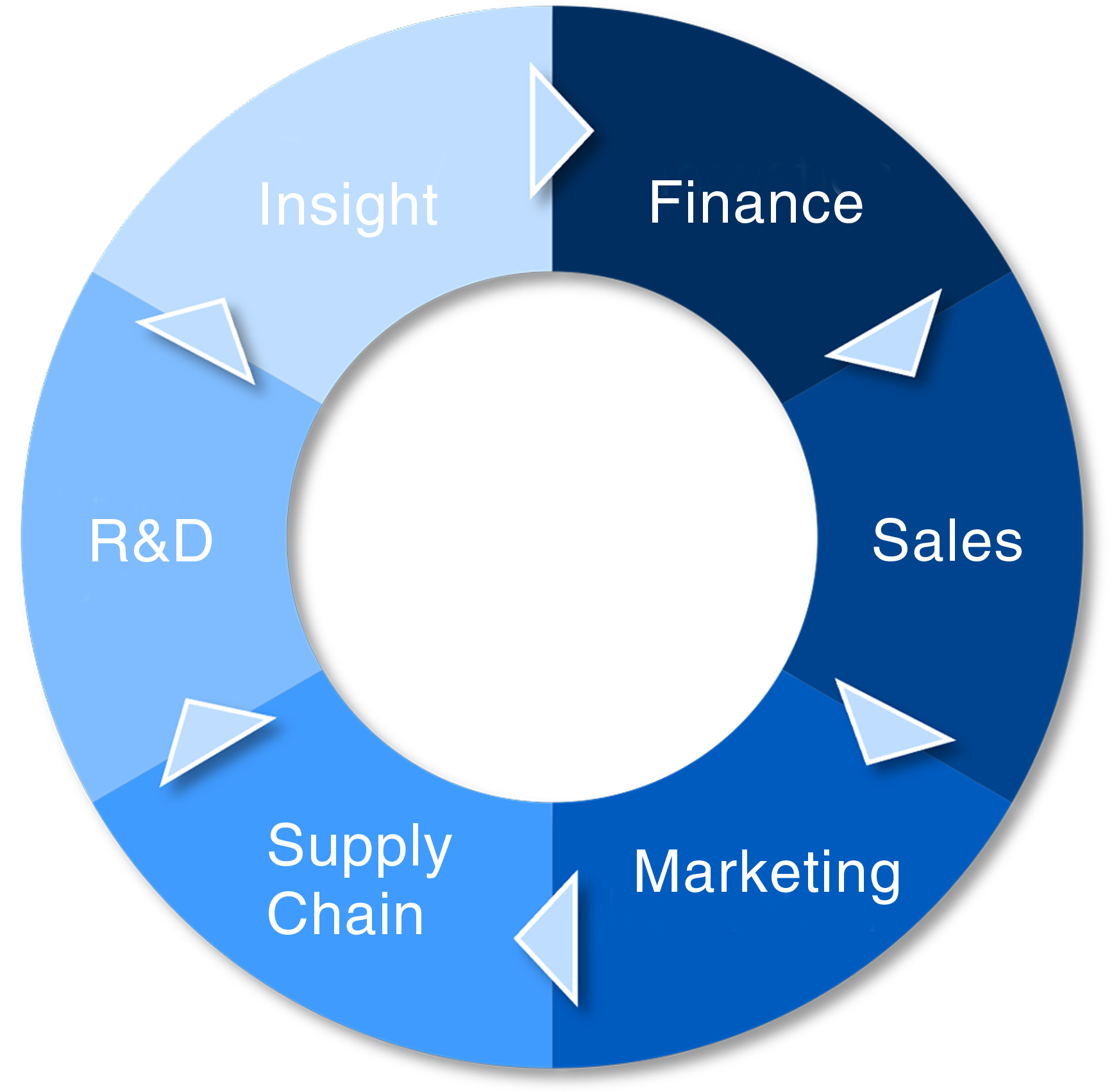Part 1: the Portfolio Review
Introduction
In today’s dynamic business landscape, the role and integration of marketing and product teams has become a critical factor in achieving organizational success. As businesses navigate ever-evolving markets and consumer preferences, the ability to seamlessly align and integrate these two key functions and their plans can make the difference between stagnation and growth.
Integrated Business Planning (IBP) solves this challenge by bridging the gap between different parts of the organization essential for brilliant planning and execution and empowering them to collaborate to drive both brand health and successful innovation.
In the first installment of this white paper series, we delve into the pivotal role and significance of effective product marketing and portfolio management within the broader business context of IBP. We underscore the substantial benefits that accrue to organizations that excel in these areas. Our primary focus centers on the critical integration point within a monthly cycle, embodied by the Portfolio Review.
Furthermore, we draw a clear distinction between the importance of managing the performance and lifecycle of the existing portfolio and, for many organizations, the strategic imperative of propelling future growth through innovation. We will build on this topic in future white papers.
This discussion serves as a foundational exploration of the key elements driving success in the complex world of portfolio management.
Why is the Portfolio Review key for business success?
IBP has emerged as the natural evolution of the traditional Sales & Operations Planning (S&OP) process. While S&OP primarily focused on aligning sales and operations, IBP takes a holistic approach, expanding its scope to encompass the entire organization.
One significant advancement in this evolution is the introduction of a pivotal step: the Portfolio Review. This strategic addition recognizes the essential role that marketing and product teams play in shaping a company’s success. By involving these teams from the very beginning IBP leverages their insights to create a seamless link between strategy and execution, ensuring that the portfolio is in sync with market demands and consumer preferences.
This early integration fosters agility and empowers organizations to proactively respond to changing market dynamics, setting the stage for a more comprehensive and agile planning process.
Class A organizations understand the power of a healthy portfolio and allocate their cross-functional resources accordingly to actively optimize portfolio value and profitability. This is when a strong Portfolio Review kicks in as step one of a monthly IBP process. It enables businesses to shape, own, and maintain the right portfolio at all times - with clear strategic focus and an aligned healthy innovation funnel to accelerate business growth.
Two highly volatile areas in an organization are often headcount and portfolio, representing the range of product and service offerings made now and in the future. As often the market, category, and brand strategies determine the portfolio, it should get a high level of attention. Furthermore, the plan and its changes need to be transparent to the business and fully integrated with demand, supply, finance, and overall business management.
Flexible business solutions are required for the current D-VUCAD (Disruption - Volatile/Uncertain/Complex/Ambiguous/Diverse) environment we now operate in, with portfolios being constantly challenged and changed due to new technology, governmental requirements, and legislation, or consumer demand and customer needs.
Regular transparent reviews involving all key stakeholders, conducted with alignment as the guiding principle, offer the ability to make precise adjustments. These adjustments empower organizations to proactively prepare and respond swiftly to market dynamics. The heart of portfolio management lies in comprehending the intended and actual roles each product plays within the marketplace, including its financial impact, cost structure, complexity, and competitive advantage.
For organizations committed to fostering enduring portfolio-linked assumptions, the rewards are superior investment decisions and more effective prioritization. IBP plays a pivotal role in this process, helping identify and revise both new and existing assumptions. Equally important, IBP provides a platform for deep exploration of how these assumptions impact the broader plan.
A recent case with a global consumer goods organization illustrates this transformational journey. They transitioned from a loose, three-year growth plan by category with vague assumptions to a meticulously stress-tested set of assumptions that form the bedrock of well-defined plans. These plans are aligned with their overarching portfolio strategy, allowing them to strategically transform key product categories.
All these parameters influence the impact of the portfolio and need to be reviewed, so that corrective actions can be taken in a timely fashion. In essence, the Portfolio Review must be step one of the IBP business cycle as the product, service, and marketing plan is orchestrating the business direction and required response. All other steps need to follow the portfolio’s lead. Indeed the construction of an unconstrained demand plan is reliant on the visibility and alignment with the portfolio and wider market assumptions that are a fundamental output of the Portfolio Review.
Figure 1: Monthly Integrated Business Planning cadence, starting with the Portfolio Review

What is in scope for the Portfolio Review?
Portfolio strategy
- Ensuring the portfolio plans deliver the business plan in context of the wider business strategy
- Reviewing guiding principles e.g., new innovation replaces an existing item and informs changes in process KPIs
- Determining the portfolio architecture and sales impact (accessing the right demand spaces)
- Performance management including complexity reduction (e.g. portfolio optimization)
Innovation and new product strategy
- Aligning on the short to long-term innovation pipeline
- Defining innovation timelines depending on business capability and changing assumptions
- Innovation funnel health and pipeline prioritization
- Technical feasibility assessment and development
- Plan assumptions as time to market and attrition
- Post-launch review
Brand strategy and health
- Advertising, media, and communication strategy
- Brand positioning
- Pricing strategy
Resource and project management
- Project management performance e.g., milestone adherence
- Balance priorities and resources
- Development of new capabilities
- Stage & Gate performance and course correction
- Resource management via a feeder process
Cross-functional inputs through IBP
An all-encompassing Portfolio Review presents a unique business opportunity, allowing organizations to proactively manage their core growth drivers and bolster their competitive advantage.
When this plan is validated through IBP with key stakeholders it becomes the driving force behind crucial business decisions related to the portfolio. To illustrate this, consider our recent collaboration with an FMCG organization. They harnessed IBP to synchronize the timing of a pivotal product innovation with their customers’ range review dates. As these dates - initially treated as assumptions - underwent changes, IBP served as their compass for course correction. This precision was instrumental in orchestrating 100% on-time-in-full first orders, the seamless timing and nature of in-outlet marketing campaigns and halo brand communication strategies. Moreover, as assumptions tied to this key innovation evolved, IBP ensured that the various functions critical for execution received informed updates, enabling a seamless end-to-end execution.
Cross-functional team input plays a pivotal role in stress-testing plans to ensure their resilience. For instance, it involves asking essential questions such as, “What is the required distribution level, and when should it be achieved, before launching key campaigns like Above The Line (ATL) advertising?” Additionally, it necessitates an alignment check across marketing, sales, and supply chain functions to facilitate this achievement, effectively pre-empting challenges and issues at the product’s actual launch.
The importance of this process becomes evident when considering market data, which reveals the formidable challenge of successfully introducing innovation, with as much as two out of every three new products failing to gain traction. Hence, leveraging IBP to rigorously stress-test the plans becomes paramount, ensuring that every possible measure is taken to position the product in the category of success.
To enable the scope and purpose of the Portfolio Review, businesses need to ensure they have the right feeder meetings and inputs, supported by cross-functional teams in place.
In more complex organizations with portfolios covering multiple categories and with various brands, establishing monthly category or brand reviews is a critical part of the process to enable the brand plans and health to be first addressed at the right level of the organization and enable one of the other key elements of IBP - pushing decision-making down to the right level of the organization to match accountability. The key outputs of these meetings enable the Portfolio Review to operate at the total portfolio level providing appropriate sign off of the plans.
Portfolio Review
Ensure your total process is aligned and designed to mirror decision-making rights and accountability:

Many leading organizations understand their portfolio and proceed accordingly to own complexity. These firms also review the portfolio according to the core business KPIs, to release resources in sales, reduce costs for production whilst optimizing marketing spend, generate more space for new or sometimes bigger ideas, and be relentless in cutting out unnecessary complexity.
Four key steps to defining the right portfolio and managing it with IBP
Four key steps to defining the right portfolio and managing it with IBP:
- Assess the portfolio performance with all your business counterparts
- Validate the insights
- Execute and action according to requirements and strategy set for the portfolio
- Sustain your portfolio through your IBP process by reviewing the strategic direction set for your portfolio, e.g. no new innovation unless an existing item can be replaced to limit complexity
Key cross-functional team input

Figure 2: Required business inputs and validation to maintain a healthy portfolio now and in the future
Gap-filling activities will always be part of the daily business, in particular during times of business decline or challenging market situations. This needs to be carefully and consciously managed via the Portfolio Review aligning on these activities to restrain from a purely tactical approach.
Gap-filling often endangers the big innovations as resources get distracted and drawn into short-term firefighting. Smart business leaders define at each step in the IBP process which part of the portfolio is needed, adding value, driving growth, or just filling a short-term gap as a tactical approach.
In consideration of this, operating a clear vulnerabilities & opportunities process from a portfolio management perspective is vital. This will generate visibility of ongoing options and by utilizing IBP meetings to make decisions the gap closing initiatives can be agreed in a controlled and deliberate way. The ability to re-distribute investment e.g. Above The Line (ATL) & Below The Line (BTL) spend, reallocate resource to potentially bring forward the date at which you are planning to introduce a new product, or look at longer-term options such as product acquisitions are good examples of where this can be used in the Portfolio Review.
In conclusion
The Portfolio Review serves as the critical inaugural step within the IBP process. It equips organizations to not only comprehend but also fine-tune their portfolio, thereby igniting the engine of their delivery capabilities. This process is meticulously designed, with a deliberate structural approach aimed at aligning with the broader business strategy and engaging a multifunctional audience.
IBP possesses the transformative power to unlock the creative thinking and dynamism of marketing and product teams, enabling them to launch and promote products that deeply resonate with consumers and customers, ultimately driving sustainable growth. Therefore, IBP should take center stage as a focal point and an enabler for all marketeers, guiding them in delivering their brand and portfolio strategies and achieving their objectives.
In the forthcoming second part of this white paper series, we will delve into the myriad of opportunities that IBP offers to marketing and product teams, exploring various tools and trigger points for making informed choices in portfolio optimization.
Ben Collins
Partner at Oliver Wight
Alexandra Lott
Consultant; former Director Business Transformation European Turkey & CIS and Lead of Regional PMR Mars GmbH